________________
INTRODUCTION
63
his illustrious brother · Asanga, pupil of Maitreyanātha. He was a contemporary of the two Vaibhāṣika teachers Sanghabhadra and Manoratha. He has written la number of works as the Chinese Tripitaka informs us. He died at the age of 80.His date is differently assigned by eminent scholars. Sir V. A. Smith, M. Peri and Dr. Bhattachārvva place him between 280-360 A.D.; some however point out that he flourished between 420 and 500 A.D. ? Date of Śrī Siddhasena Gani
At the end of the commentary there is a colophon which supplies us with the first hand information about the commentator Siddhasena as it is a piece of his own work. From this we learn that he is a pupil of Bhāsvāmin, pupil of 'Simhasūra, pupil of "Dinna Gani Ksamāśramana. There is neither the date of this commentary mentioned nor is the date for any of his predecessors, finally settled. Furthermore, there is no other work definitely ascribed to him and universally accepted which may help us in solving the problem of his date. Of course, Pandit Sukhlal. identifies him with Gandhahastin referred to by Sri Sīlānka Sūri of the ninth century in his commentary to Ācārānga (pp. 1 &82) and also referred to by Sri Abhayadeva Sūri in his commentary to Sanmatitprakarna (pp. 595 & 651). He opines that the unavailable commentary from which Śīlanka borrows is one of the other works of this brilliant scholar. As the work is unavailable, nothing can be gained thereby. Moreover Himavanta pattāvalı of which the Gujarati translation is published by Pandit Hirała nisarai. goes against this statement. We have therefore to rely upon the internal evidence viz. the names of authors and works and
1. For the names see the Foreword of Tattvasangraha (pp. LXIX-LXX). 2. See Early History of India by V. A. Smith p. 329 (3rd. edition).
3. If he can be identified with Simha Sūri, the commentator of Sri Mallavā. din's Nayacakra (Dvādaśāra) it may be inferred that this commentary must have been composed in the seventh century.
4. If we are justified in inferring from the second stanza of the colophon that Dinna Gani, the third predecessor of our commentator flourished in or about 980 Vira era ( 454 A. D.), the date of redaction of the canon or codifying of the pravacana, we may surmise that he could not have lived earlier than the seventh century, since he flourished three generations later.
5. Is Aryaganga referred to on p. 169 the same as the fifth nihnava Ganga who flourished 228 years after Vira's liberation ?
6. Siddhiviniscaya and Srstiparikşā are quoted on p. 37 (pt. I.)
I do not think that it is possible to equate this Siddhiviniscaya with that of Akalankadeva, commented upon by Anantavīrya.
Jain Education International
For Private & Personal Use Only
www.jainelibrary.org




